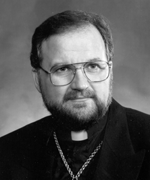 HYPE VERSUS HOPE
HYPE VERSUS HOPESOME REFLECTIONS ON MEL GIBSON'S FILM ON THE PASSION OF JESUS
Most Rev. Stefan Soroka
Metropolitan of the Ukrainian Catholic Church in U.S.A.
Archbishop of the Archeparchy of Philadelphia
 HYPE VERSUS HOPE
HYPE VERSUS HOPE
SOME REFLECTIONS ON MEL GIBSON'S FILM ON THE PASSION OF JESUS
Most Rev. Stefan Soroka
Metropolitan of the Ukrainian Catholic Church in U.S.A.
Archbishop of the Archeparchy of Philadelphia
September 29, 2003
Webmaster's Note: Most Rev. Stefan Soroka is one of a few bishops who have been invited to a screening of a rough cut of this upcoming film. Although one or two others have spoken publicly about their favorable reactions, and others have expressed reservations privately, this is to our knowledge the first detailed analysis of the film by a member of the Catholic hierarchy. Readers should recognize that the eventually released theatrical version may differ in some ways from the version reviewed here. We thank the Metropolitan Archbishop for allowing us to post his reflections here.
Having had the opportunity to view an unedited version of Mel Gibson's film The
Passion, I can begin to understand the developing hype and controversy
regarding this soon-to-be-released movie. I suggest that the hype, in part being
engendered and fueled by the producers of the film, is necessary because of the
rather shallow content of the movie itself. I would not recommend the movie to
my friends nor to the faithful (and particularly the young), because the film,
while interesting in the way some things are portrayed (particularly evil),
lacks content to really engage my interest.
If you want to see over two hours of cruelty, intense torture, and lots of
blood, with tidbits of informing scenes of who this Jesus is, you might want to
sacrifice your time and money to see this movie. The Passion makes an
extraordinary effort at presenting the horrific effects of a crucifixion, a very
cruel punishment inflicted by the
My comment to Mr. Gibson and his staff at the viewing was that I was left with
the gnawing question, "Where is the hope?" In the unedited version,
there is nothing to suggest or to offer hope in Jesus Christ, in light of his
crucifixion and resurrection. A number of representatives of other faiths also
present at the viewing drew attention to this significant element of Christian
faith; that is the resurrection of Jesus Christ in light of his crucifixion. The
producers' hope is that viewers will be intrigued enough with the intensity of
suffering endured by Jesus, and will thus then be inspired to search him in the
scriptures. And yet, the hype of the producers suggests that the film leads one
"to identify with the new, life, hope and forgiveness he offers". The
film does not invite me to a yearning for these.
What is particularly intriguing in the film is the manner in which Mel Gibson
portrays evil. The human-like figure of evil seemingly glides through various
scenes, always in intense eye contact with its adversaries. Often very little or
nothing is said, as is presented in a scene where Mary, the Mother of Jesus, is
presented very beautifully as a strong woman, confident in her faith, and yet
very mournful and compassionate while witnessing the passion being endured by
Jesus.
Particularly troubling is the manner in which Caiaphas, the chief [priest], and
some members of his Sanhedrin are portrayed. Caiaphas is not presented as
a learned rabbi, making what one would expect, that is a reasoned argument from
his perspective for the crucifixion of Jesus. Rather, Caiaphas' demands are
placed in a framework of having much greater influence with authorities in
Hype or Hope? Just a few days after the viewing, the film's producers asked the
viewers by e-mail to provide letters of support for the film to "help them
gain momentum right now". They gave us the green light to speak about the
movie, and offered assistance to promote the movie among our constituents. This
article is my attempt to provide a reflection on the movie, its merits and its
potentially divisive effects on interfaith understanding and dialogue. What is
most unfortunate is that the film's shallow presentation on the life of Jesus
and the significance of the resurrection will leave viewers focused on the harsh
and cruel reality of the crucifixion of Jesus, offering little opportunity to
identify with the life and hope offered in Jesus Christ for all mankind. The
shallow presentation of the high [priest] and his role, as well as the close
personification of evil journeying with him, will give viewers an inaccurate and
unjust portrayal of Jews and Judaism, and may contribute to fuel the ugly
passion of Anti-Semitism.
Frankly, without the hype, this movie will not interest many viewers because it
fails to offer hope